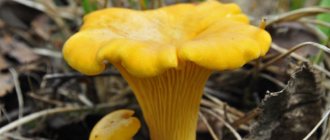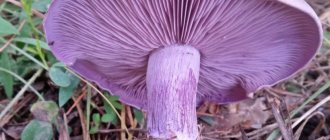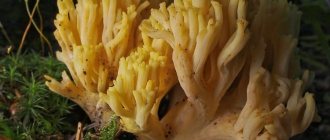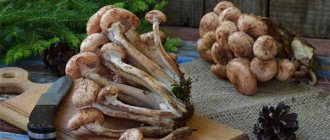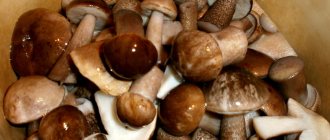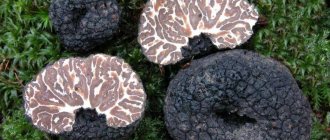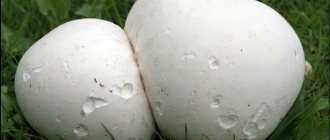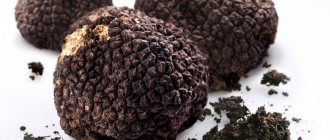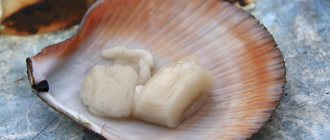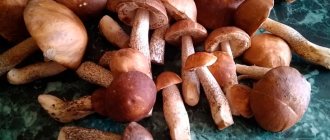Honey mushrooms
Small mushrooms with round caps appear in friendly groups on green meadows or stumps. Fragrant and generous in harvest, honey mushrooms have a delicate taste and are suitable for a variety of mushroom dishes. They are successfully salted, pickled, boiled and roasted. A few small fragrant mushrooms will flavor potato soup or pasta, making the simplest dish original, satisfying and healthy.
External characteristics
What do autumn mushrooms look like? Below is a complete description of this edible and healthy mushroom.
Cap: autumn specimens have a cap with a diameter of 5 to 10 centimeters (in rare cases, mushrooms with a cap diameter of 15 centimeters are found). Young individuals have a spherical cap, with the edges pulled inward, followed by a flat-convex tubercle in the center, yellow-brown or gray-yellow in color with the presence of small brown scales.
Plates: the plant’s plates are somewhat descending, often located, initially have a light yellowish tint, then a light brown tint, often with dark spots. White spore powder.
Stipe: Mushrooms have a stalk that is 6 to 12 centimeters long, with a diameter of 0.5 to 2 centimeters. The stem is cylindrical in shape with a thickening at the bottom in the form of a tuber. There is a white ring on the top of the leg. The color on top of the stem is light, closer to the roots it is dark.
The flesh of the mushroom is tough and fibrous.
Content:
- External characteristics
- Spreading
- Similar species
- Edibility
- Signs of difference from a false double
- Growing mushrooms at home
- Methods for harvesting mushrooms for the winter
- How to marinate correctly
Calories and nutritional value
Autumn honey fungus is a valuable food product. It consists of 90% water and high-quality protein, which is well absorbed by the body. The amount of protein is not inferior to meat. So in dry honey mushrooms its content is twice as high as in beef. This quality of the mushroom will be especially appreciated by vegetarians.
The chemical composition of autumn honey fungus is rich in vitamins, especially B vitamins, as well as macro- and microelements. So 100 gr. mushrooms satisfy the body's daily need for zinc and copper.
Despite all its advantages and high taste qualities, the calorie content of autumn honey mushroom is low, which is beneficial for people watching their weight.
Data are given per 100 g. product:
| Name | Quantity |
| calories, kcal | 22 kcal |
| squirrels | 2.2 gr. |
| fats | 1.2 gr. |
| carbohydrates | 0.5 gr. |
| cellulose | 5.1 gr. |
| water | 90 gr. |
| vitamins | |
| beta carotene | 0.5 mg. |
| B1 (thiamine) | 0.02 mg. |
| B2 (riboflavin) | 0.38 mg. |
| B3 (nicotinic acid) | 10.7 mg. |
| B5 (pantothenic acid) | 1.35 mg. |
| B6 (pyridoxine) | 0.1 mg. |
| B9 (folate) | 48 mcg. |
| C (ascorbic acid) | 11 mg. |
| E (tocopherol) | 0.1 mg. |
| macronutrients | |
| potassium | 400 mg. |
| magnesium | 20 mg. |
| calcium | 5 mg. |
| iron | 0.8 mg. |
| microelements | |
| aluminum | 7739 mcg. |
| copper | 85 mcg. |
| nickel | 47.1 mcg. |
| phosphorus | 45 mg. |
| sulfur | 10 mg. |
| chlorine | 5.7 mg. |
| chromium | 5.5 mcg. |
| sodium | 5 mg. |
| boron | 2.4 mcg. |
| selenium | 2.2 mcg. |
| and | |
| mono- and disaccharides (sugars) | 0.5 gr. |
| saturated fatty acids | |
| myristic | 0.007 gr. |
| palmitic | 0.138 gr. |
| stearic | 0.021 gr. |
| monounsaturated fatty acids | |
| palmitoleic | 0.096 gr. |
| oleic (omega-9) | 0.343 gr. |
| polyunsaturated fatty acids | |
| linoleic | 0.312 gr. |
| omega-6 fatty acids | 0.31 gr. |
Important! The information presented in the material is for informational purposes only. Before use, be sure to consult a specialist.
Similar species
Autumn honey mushrooms can only be confused with scaly fuzzy mushrooms (distinguished by the presence of an abundant amount of scales, a rare smell and a bitter taste). Many sources indicate false types of autumn honey mushrooms: brick-red and sulfur-yellow, which are similar to autumn ones only in the place of growth (on stumps) and nothing more.
Some authors separately identify a thick-legged variety, which has a thin cobwebby cover, a pot-bellied leg, and grows exclusively on dead and decrepit stumps, less often found on deciduous autumn litter.
Another similar variety is the dark honey fungus; it can most often be found on coniferous wood. It differs from the autumn one by the presence of too dark scales on the cap.
Habitat
Autumn honey fungus is widespread throughout Europe and the CIS countries from the subtropics to the North, excluding permafrost regions, where it can be found quite rarely.
The mushroom bears fruit very abundantly. Appears in large colonies and also forms clusters. Single mushrooms are quite rare.
Where does autumn honey fungus grow?
Autumn honey fungus settles on both living and dead trees and stumps. It can be seen at the roots of healthy trees, on or near fallen trunks. In favorable conditions it grows on leaves and moss.
Autumn honey fungus grows on both coniferous and deciduous trees (birch, aspen, oak, willow, alder, poplar, white acacia, mulberry, elderberry, etc.). In particularly fruitful years, it can “attack” garden and ornamental trees and shrubs, affecting herbaceous plants such as potatoes, etc., and even flowers.
Autumn honey fungus prefers damp places. It can be found both in deciduous, coniferous and mixed forests, in clearings, cutting areas, in ravines, along roads, as well as in parks, squares, gardens, etc.
The yield of autumn honey fungus is quite high: in favorable years it can reach 265-405 kg/ha, in unfavorable years – up to 100 kg/ha.
Edibility
Autumn honey mushrooms belong to the group of good edible mushrooms that require high-quality and thorough heat treatment before use. This product can be consumed in the form of powder, pickling, marinade, as well as boiled, dried or fried. It is recommended to eat the caps, but the legs are suitable for consumption only when they are young (old specimens have tasteless and tough legs).
Contraindications
Whatever the useful product and whatever gastronomic qualities it has, before use you should always take into account not only the benefits, but also the contraindications of the autumn honey fungus that it has.
First of all, you should pay attention that some classifications classify autumn honey fungus as conditionally edible mushrooms due to the presence of a small amount of toxins in raw fruiting bodies, which are destroyed when boiled. Even undercooked mushrooms, when eaten, can cause intestinal upset. How long should you cook autumn honey mushrooms for safe consumption? At least half an hour.
As for the harm that this species can cause, since mushrooms are difficult food for the digestive system, if you have any diseases of the digestive tract, they should be consumed with caution. And in the acute stage, exclude it from the diet altogether.
In addition, it is not recommended to use autumn honey mushrooms when:
- pancreatitis,
- having an allergy to mushrooms.
Also, if you have a sensitive stomach and intestines and a tendency to allergic reactions, you need to be careful and include autumn honey fungus in your diet gradually, starting with a small amount.
Many people are interested in the question: is it possible to use autumn honey mushrooms for children? Since children under 7 years of age have a digestive system that is not yet fully developed, they should not be given dishes with autumn mushrooms.
Signs of difference from a false double
How to distinguish dangerous doubles of the autumn honey fungus? False autumn mushrooms have a smooth cap, while real ones have scales. Real ones have dull colors, while false ones are more expressive and catchy in color. The underhat plates are cream-colored, but in false mushrooms they are gray or yellow. Adults of real mushrooms have a pleasant smell, and a skirt is formed under the cap. Most often you can find false ones, sulfur-yellow, yellow, gray-plate, brick-red type. In order not to collect false dangerous individuals, you need to be as careful as possible.
Northern honey fungus
He is also the northern autumn honey fungus. In many ways it is similar to the previous mushroom, except that it differs in color - it is more often light brown than yellow, at least in our area. It also sometimes looks a little stronger.
Photo 5. Mature fruiting bodies of the northern honey fungus. Author: Kärt Urman.
In terms of other characteristics - from the preferred forests to the timing of fruiting - this mushroom fully corresponds to the autumn honey fungus.
Growing mushrooms at home
To grow autumn mushrooms at home, you need to find old mushroom caps with mature mycelium in the forest. The hats need to be gently and thoroughly kneaded in water. The resulting mycelium solution should be poured onto a tree trunk or stump. You can also nail the mycelium to a tree or stump.
Mushrooms grow very quickly, usually appearing within a week after rain. Autumn honey fungus is a popular and abundant mushroom. It is for this reason that they try to prepare them in different ways and preserve them for the winter. The main methods of preparing honey mushrooms are salting, boiling, drying, frying, pickling and freezing. There are a wide variety of recipes, including: stewed honey mushrooms in sour cream and tomato sauce, mushroom pizza, solyanka with mushrooms, salad with vegetables, honey mushrooms and sour cream and garlic dressing, and even honey mushroom caviar.
How to collect
Autumn honey mushrooms, depending on the region and weather, begin to bear fruit in July. And these wonderful mushrooms can be found until the first steady frost. On average, the autumn honey mushroom season is the end of August - October.
This species grows in waves. During the season, 2-3 waves of fruiting are observed, each of which lasts 15-20 days. Honey mushrooms are especially prolific with the onset of the first cold nights. It is believed that lowering night temperatures below 10°C stimulates their active growth. Morning fogs and rainy weather also contribute to the mass appearance of autumn honey mushrooms.
Autumn honey mushroom harvest
When collecting, it is better to give preference to young specimens, which are suitable for all types of culinary processing and are less affected by pests. With age, the legs of autumn honey mushrooms become very hard and fibrous and are not suitable for food, so only the caps are collected from them.
Many people are interested in how to prune autumn honey fungus correctly. To avoid damaging the mycelium and splitting the stem, use a sharp knife to cut off the mushrooms at the very base. To ensure that the mushrooms continue to enjoy the harvest in this area, the cut site is sprinkled with leaves or grass.
Autumn honey mushrooms have elastic flesh and performed well during transportation. Therefore, you can use not only traditional baskets, but even bags.
In addition, you should pay attention that mushrooms tend to accumulate all kinds of toxins and heavy metals from the soil. Therefore, to collect autumn honey mushrooms, you need to choose environmentally friendly places, away from industrial enterprises, roads, etc.
Methods for harvesting mushrooms for the winter
Before you begin directly harvesting mushrooms for the winter, you need to thoroughly wash them to remove sand and dirt and cut off the bottom of the stems that were in direct contact with the ground. For pickling, it is better to give preference to very young or already old mushrooms. From old mushrooms, only the caps are suitable; the stems are very hard. For freezing, you need to use clean, dried, fresh or fried mushrooms. For pickling, pre-boiled mushrooms are used. For drying, dense mushrooms are used; there is no need to wash them before drying. Dried honey mushrooms are usually used during the preparation of soups, as they are somewhat harsh. For preservation, you can fry honey mushrooms with the addition of onions and carrots, pour them hot into jars, pour melted pork fat and roll them up. It is worth remembering that undercooked mushrooms can cause stomach upset. How long to cook? At least half an hour.
Best materials of the month
- Coronaviruses: SARS-CoV-2 (COVID-19)
- Antibiotics for the prevention and treatment of COVID-19: how effective are they?
- The most common "office" diseases
- Does vodka kill coronavirus?
- How to stay alive on our roads?
Where do honey mushrooms grow?
Forest mushrooms can grow in a wide variety of climates. They are able to cover fairly large areas and grow in large areas. Most often they can be found near stumps and small bushes.
As a rule, they can be hidden under leaves or in the grass, although sometimes you can find a mushroom standing alone in the middle of the path.
Chemical composition
Using instrumental methods of analysis, mixtures obtained from autumn honey fungus were studied and their individual components were determined, in particular: ficin, mannose, azelaic acid, orsellinic acid, hydroxymethylfurfural, 3-methyl-5-methoxyphenol, orsinol-monomethyl ether, 3-methyl- 4-chloro-5-methoxyphenol, orsinol, Daidzein (estrogenic isoflavone), stearic acid, palmitic acid, linoleic acid, glycerol a-monooleate. In addition to the above components, purine derivatives have been isolated: guanosine, adenosine, N6-dimethyladenosine, N6-methyladenosine, 2″-methyladenosine, purine and 17 more aromatic sesquiterpene compounds.
Intracellular poliose was isolated from the rhizomorph of the autumn honey fungus, the analysis of which showed that it contains uronic acid, D-glucose, D-galactose, D-mannose, and D-xylose. Tanzhou and co-workers (2002) isolated neutral and several acidic polyoses from fungal culture fluid. They found that one of the neutral polyoses is a glucan and contains β-glycosides. Data from other authors have shown that polyose from the mycelium and culture fluid of the fungus is a glucan, which consists of glucose monomers; poliosis of the rhizomorph and fruiting body consists of glucose and xylose, their molar ratio in poliosis of the rhizomorph is 1:14, in poliosis of the fruiting body - 1:10. The molecular weight of honey fungus poliosis is 10,000 - 70,000 Da. At different stages of fungal growth, the poliose content may change. Thus, the content of poliose in the mycelium is 9%, in the culture liquid - 0.87 g/100 ml; in rhizomorph - 1.12%; in the fruit body - 2.27%. Zhangjia et al. (2002) isolated three new fractions from the fruiting body of the fungus. Two fractions are mixtures of sterol, one is ceramide C-18. In addition to them, water-soluble glucan and peptidoglucan were isolated from fruiting bodies.
Honey fungus shrinking
He is also an oak honey fungus, a ringless honey fungus. Another species from the genus of true honey mushrooms, preferring broad-leaved species to other trees. It is most often collected from oak trees, which is why it received one of its alternative names. It is also not called ringless for nothing - the fruiting bodies of the honey mushroom do not have a drying cover, so its stem is always without a ring, which greatly increases the chances of confusing this mushroom with false honey mushrooms, so only experienced mushroom pickers collect it.
Photo 10. Close-up of the fruiting bodies of the shriveling honey fungus. Author: Katja Schulz.
However, the typical “honeycomb” hairiness of the fruiting body and the presence of scales on the cap are eloquent signs that make it clear that we are dealing with a representative of true honey mushrooms.
This mushroom bears fruit from July to October . In warm summers, fruiting bodies may appear earlier - as early as June.
In terms of taste, the shrinking honey mushroom corresponds to other real honey mushrooms.
Growing in the garden
For this you will need:
- mushroom mycelium (organic substance).
- wood chips, sawdust from deciduous trees;
- mulched tree bark or straw (for bedding);
- corrugated cardboard;
- water:
- shovel.
First we need to choose a place in the garden where our mushrooms will grow. The ideal place is close to trees, in partial shade, with loose, fertilized soil. The ideal time is spring. To prevent rodents from spoiling the mycelium, you should not use mycelium on a grain substrate. In the selected location, we dig up soil 10-12 cm deep. The dimensions of the resulting hole should take into account the further growth of the mycelium by 2-2.5 times.
Growing honey mushrooms on a substrate.
We lay corrugated cardboard at the bottom of the resulting hole. This will be the lowest layer of our mycelium. Place a layer of 0.5-1 cm of sawdust on the corrugation. We begin to pour plenty of water into the hole. When all the water has been absorbed, spread the mycelium evenly on the substrate. Lay out a layer of mulch or wood chips. Water again. Next, spread a mulched light layer of soil to the general level. Above the level, so that the soil does not dry out, lay it out with straw or mulched tree bark and water it abundantly again.
In the future, it is necessary to monitor the condition of the soil and as soon as the soil at a depth of 3-4 cm is dry, it is necessary to immediately moisten it. The first harvest will be received very soon. It is recommended to collect mature mushrooms daily during fruiting so that the mycelium does not get sick. For the winter, it is advisable to additionally cover the mycelium, thereby protecting it from freezing. Mushrooms are very popular with snails and slugs. Do not use any chemicals to kill pests! Mushrooms quickly absorb poisons. Use artificial traps or collect pests by hand.
Poplar honey mushrooms on stumps.
How to properly prepare the substrate
You will need to prepare specialized soil. The substrate is prepared from two parts of sawdust (or sunflower seed husks) and 1 part of shavings. The ingredients are mixed, boiled in water, and strained.
Additional material: What mushrooms look like and where to collect them
You should get a mass of porridge-like consistency, add starch, corn and oatmeal in a ratio of 8:25:25 per kg of substrate. In a greenhouse, you will need a block of sawdust, barley and oats, and chalk. You need to choose sawdust from hardwood trees. Substrate example:
- Combine 200 g of dry sawdust with two liters of water and cook over low heat for 2 hours;
- add 70 grams of oats and 1 tsp to the cooled mass (up to 25 ºC). chalk;
- Mix the mixture well and pack into bags.
